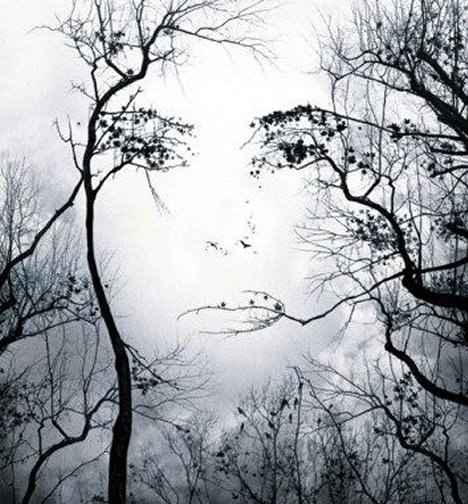
Corner House
I am amazed some of the images and paintings that people do, specially optical Illusion images and how our mind sees it. What is optical illusion and why it works on us? Simply putting that an optical illusion is characterized by visually perceived images that differ from objective reality. The information gathered by the eye is processed in the brain to give a perception that does not tally with a physical measurement of the stimulus source. Our mind is much powerful and many think what our eyes sees, mind processes but according to some experts, what we see is actually what our conscious mind has computed, while our subconscious mind sees the what is actually presented but we might be unaware of it.
 Can you find them all?
Can you find them all?
 What do you see in above image? a lion who is sitting or is it a hand print?
What do you see in above image? a lion who is sitting or is it a hand print?
There are many famous artists are also popular illusionist, such as M. C. Escher, Giuseppe Arcimboldo, Victor Vasarely, andPatrick Hughes, and many others. Here are some of the optical Illusions for your own viewing pleasure.
 Vanishing Venice: Patrick Hughes
Vanishing Venice: Patrick Hughes
The above picture surface of Vanishing Venice is 3-dimensional, made of two pyramids protruding towards the viewer with the tops cut off: the bases of the pyramids are farthest away (flat against the wall). The two lighter rectangles which appear to be in the distance at the end of the buildings are the flat tops and thus the part of the image physically nearest to the viewer (see diagram below to see how image was constructed). How Vanishing Venice Image is constructed (see above)
How Vanishing Venice Image is constructed (see above)
 Do you trees or woman’s face?
Do you trees or woman’s face?
What you see is NOT what you get always!
Since ancient times, menkind have known that immediate perception is not a reading of physical reality.Vision is one of the most creative act that we are capable of doing as seeing is analyzing the world on our mind canvas. Our mind can work as artist and viewer. Our eyes process what what we know and if something appear out of ordinary, our eyes automatically ignored it more normal and acceptable outcome.
 M. C Escher’s Reality (1953)
M. C Escher’s Reality (1953)
The German poet Novalis said that the eye is a ‘superficial’ organ. That is indeed partly true. Our eyes are external organ to what we the world is part of world, which pops in it as soon as we open our eyes!
 Wall Painting
Wall Painting
 Ron Gonsalves: Acrobatic Engineering
Ron Gonsalves: Acrobatic Engineering
 Tree House: Looking up or down
Tree House: Looking up or down
Rob Gonsalves’ work is often categorized as surrealistic, it differs because the images are deliberately planned and result from conscious thought. He seems to injects a sense of magic into realistic scenes. As a result, the term “Magic Realism” describes his work accurately. His work is an attempt to represent human beings’ desire to believe the impossible, to be open to possibility. You can see more of his work here.
Sometimes, these optical illusions are fun, other times they might be used in advertising to influence us in to buying their product.
Rotating  Moving Image: By Akiyshi
Moving Image: By Akiyshi
Some of the moving images can give a few people headache or dizziness, as I was surprised to learn while searching for answers on why it works. If you are getting spinning or headaches, you may want to stop looking at the images.
M. C Escher Like Image
Another M. C. Escher Like Image
 Outdoor Sculpture By Victor Vararely
Outdoor Sculpture By Victor Vararely
Victor Vasarely was a Hungarian French artist whose work is generally seen aligned with Op-art. His work entitled Zebra, created by Vasarely in the 1930s, is considered by some to be one of the earliest examples of Op-art. Above picture is displayed at at the church of Pálos in Pécs, where he was born.
 Carpet Flooring
Carpet Flooring
In this modern day, this carpet gives us an illusions of floor with ripple and hills. Can you imagine trying to dance on this floor? Forget dancing, walking alone might be challenging for a few of us.
 Movement is Square (1961)
Movement is Square (1961)
Above image of Movement is Square is one of few female op arts painter image by Bridget Riley. She is one of the foremost proponent of op art. “Optical art is a method of painting concerning the interaction between illusion and picture plane, between understanding and seeing.”Op art works are abstract, with many of the better known pieces made in only black and white. When the viewer looks at them, the impression is given of movement, hidden images, flashing and vibration, patterns, or alternatively, of swelling or warping.
 What do you see here?
What do you see here?
 Can you find infant in this image?
Can you find infant in this image?
 Are they up or down? another Escher Like Image
Are they up or down? another Escher Like Image
 How to make someone more taller, even when they are not?
How to make someone more taller, even when they are not?
 Can you find hidden deer in this image?
Can you find hidden deer in this image?
 Old couple looking at each other or folk singers singing and playing?
Old couple looking at each other or folk singers singing and playing?

Summary:
Being aware of an possibility of impossible can open up your eyes to see tricks of mind. Images can be ambiguous and completion figures, impossible figures, hidden objects, illusions involving colors, geometric illusions, illusory moving patterns, verbal illusions and visual paradoxes. Hopefully, we can learn to be more aware of when we see to discover how we may perceive things, test of critical thinking by looking at seeming impossible things and improve our mental brain capacity and of course, most important part of it all is have fun while doing it all!
Image Source: Wikipedia, Blogspot site, WTV Zone
8 Kids Books That Everyone Should Read is a post from: Heart and Mind
Related posts:
- Humor: Kids say funniest things:3 I had started a Kids Talk series in early days…
- Time To Reflect and Find Focus Again How have you all been? I have been going through…
- How To Create A Life That Does Not Need To Escape From: Part 1 While we can not always choose many aspects of life,…
Related posts brought to you by Yet Another Related Posts Plugin.
View full post on Heart and Mind
